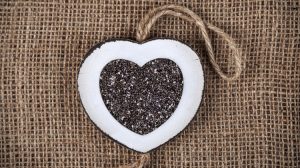22

Chia Seeds
Chia, salvia hispanica, is a species of flowering plant in the Lamiaceae family. This annual herb is native to Central America, and was cultivated by the Aztec and Mayan civilizations during pre-Columbian times.
Chia grows to a maximum height of around 5 feet, and produces white or purplish-blue flowers. It is grown commercially for its seeds, and can be grown in USDA hardiness zones 9 through 12. The seeds are speckled and contain shades of white, black, brown, and gray.
Chia seeds are rich in omega 3 fatty acids and a number of B vitamins and minerals. Per 100 gram serving, chia seeds contain the following vitamins and minerals, along with their corresponding recommended daily value percentage.
- Manganese – 110%
- Magnesium – 94%
- Phosphorus – 77%
- Copper – 69%
- Calcium – 67%
- Thiamine (B1) – 53%
- Iron – 45%
- Niacin (B3) – 43%
Chia seeds also contain trace amounts of other vitamins and minerals, as well as an assortment of healthy fats, fiber, and protein. In fact, per 100 gram serving, chia seeds contain 151% of our recommended daily value of fiber, and 31% of our daily value of protein.
Chia Seeds Benefits
The name chia comes from the Mayan language and means “strength”. Which is no coincidence, as this is one of the benefits of consuming this tiny, but super, seed. In fact, Aztec warriors used to consume chia seeds prior to heading into battle.
Chia seeds are a fantastic source of antioxidants. Antioxidants are essential for proper health, as they reduce the effects of oxidative stress caused by free radicals in the body. Oxidation causes damage to DNA and other cell structures and has been linked to over 60 diseases.
Antioxidants combat the effects of oxidation by donating an electron to free radicals, which in turn stabilizes them. Antioxidants minimize the harmful effects of toxins and pollutants. They stimulate genes that increase the body’s defense system. They slow the aging process. And they stop and prevent the spread of disease. So yah, they’re pretty important.
This 2014 study looked at the phytochemical and nutraceutical potential of chia seeds.[113] Researchers found a number of phenolic compounds and isoflavones that contribute to their antioxidant activity, and concluded that “chia could be considered a seed with high antioxidant capacity.”
Chia seeds are also one of the highest sources of protein in the plant kingdom, which is extremely beneficial if you’re a vegetarian. Chia seeds are also high in omega 3 fatty acids, surpassing even the mighty flax seed. And they’re ridiculously high in fiber. In fact, by weight they are an insane 40% fiber.
This combination of protein and fiber in chia seeds make them an ideal weight loss food. The protein aids weight loss by reducing appetite, and both help by giving the body a feeling of being fuller for a longer period of time. And then there’s the gelling action of chia seeds, which really helps you feel fuller longer. Check out this video, as chef Julie Morris talks about this special benefit of chia.
One recent study discovered that chia seeds have diabetic benefits, which in turn can also aid weight loss.[114] Researchers found that chia seeds improved insulin sensitivity and glucose tolerance, while also reducing liver and cardiac inflammation. Diabetics suffer from insulin resistance, which means they require more of it. And insulin resistance has been known to increase belly fat.
Chia seeds have numerous benefits that include …
- Reduced blood pressure
- Improved cardiovascular health
- Lower risk of diabetes
- Cholesterol and blood sugar normalization
- Relief from inflammatory bowel disease
- Stronger teeth and bones
- Improved liver health
- Increased strength and stamina
- Aiding weight loss
A 2014 study discovered that chia flour reduced blood pressure in hypertensive adults.[115] Subjects were given 35 grams of chia flour each day or a placebo. The chia group showed a reduction in both ambulatory and systolic blood pressure, reaffirming chia’s impact on heart health.
Another study on the effects of chia seeds on lipid content and fatty acid composition further substantiated its cardiovascular benefits.[116] Results showed that chia seeds significantly increased fatty acid composition in rats, which can aid in the prevention of coronary heart disease.
For those of you sensitive to gluten, or those of you just trying to eat healthier, this 2014 study examined the nutritional differences between bread made with wheat versus bread made with chia seed flour and tartary buckwheat.[117] The gluten-free bread made with chia flour contained 20% more protein, 67% more alpha-linolenic acid (a type of omega 3 fatty acid), and a whopping 74% more fiber.
Chia Seeds Uses
Chia seeds are extremely versatile, and can easily be sprinkled on top of salads, yogurt, and oatmeal. You can add chia seeds to smoothies, use them in homemade energy bars, or baked goods. You can even make chia seed pudding. You’re only limited by your imagination … and your internet availability.
This new-fangled invention is a fantastic source for recipes, and my favorite is Pinterest. Check out their chia seed recipes page for more mouth-watering (really, wear a bib!) ideas than you thought possible. Another of my favorites is Navitas Naturals, and they have their own chia seed recipes page as well. Also extremely bib-worthy.
I get all my chia seeds from Navitas Naturals. You can probably find them in your local grocery store, but if not, you can definitely purchase them through iHerb. I choose iHerb instead of the Navitas Naturals website because they’re lower in price. Which is a good thing, no? And, again, if you follow that iHerb link, you’ll get an additional $5 off your first order. Which means you’ll probably spend about half as much as you would at the grocery store. I just love saving money!
